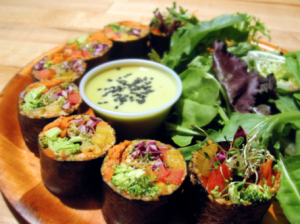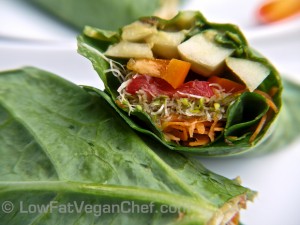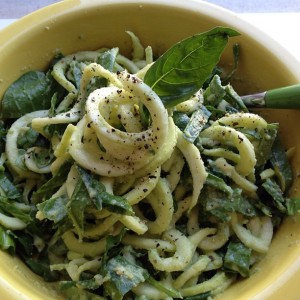Somehow the 80/10/10 low-fat raw vegan diet (aka a high-fruit diet) is misunderstood as an all-fruit diet. Yes, it is heavy on the sweet fruit, but it is also heavy on the vegetables, especially tender, leafy greens that are ready to eat raw.
I’m going to break down this misconception for you and then surprise you!
First, all fruits and vegetables contain a combination of carbohydrate, protein and fat. For example a cucumber has 83% of its calories from carbohydrate, 11% from protein and 6% from fat. Amazing, huh? (And that’s not even the surprise I have for you!) A peach has 86% of its calories from carbohydrate, 8% from protein and 6% from fat. Wow!
It is not commonly understood that fruit has protein, is it?
So when eating an 80/10/10 high-fruit diet, the goal is to eat 80% minimum of your daily calories from raw carbohydrates, 10% maximum of your daily calories from raw protein and 10% maximum of your daily calories from raw fat. When eating an abundance of sweet fruit, it is crucial to keep your fat intake low, here’s why.
Raw is important because all the water, enzymes, vitamins, minerals, fiber and molecules are intact. It’s Mother Nature’s perfect food for you!
So how do you know how many calories a day you need? Every living human needs approximately 1,200 calories a day to breath, pump blood, metabolize, think, and do basic functions. If you are quite sedentary (desk job, immobile, wheel-chair bound) you can add another 100-300 calories to your daily intake.
If you are fairly active you can add 300-600 more daily calories to fuel your walking here & there, housecleaning, playing with the kids and pets, gardening, grocery shopping, and other active, but not highly athletic, pursuits.
If you exercise daily and/or are very active, you can add 700-800 more calories. Those training for or participating in long-distance or highly-specialized events or manual labor could add upward of 1,500 extra calories or more.
When gauging your daily caloric needs (and each day may differ so estimate an average) you also want to keep in mind if you want to lose weight, maintain weight or gain weight. Once you’ve determined your average daily caloric needs, you can shave off 100+ calories to slowly lose weight over time or add calories to slowly gain weight.
For simplicity’s sake, let’s say I am moderately active and work-out about 3 days a week. On average let’s estimate that I need roughly 1,800 calories a day to maintain my weight, fitness and activity levels.
So, according to 80/10/10, I would need approximately 1,440 calories a day from raw carbohydrates, 180 calories from raw protein and 180 calories from raw fat.
Since all raw fruit, raw vegetables, raw seeds and raw nuts are comprised of a combination of carbohydrates, protein and fat, eating any of these foods will start to build up your daily requirements. There are no raw, unprocessed foods that are only carbohydrate, only protein or only fat.
Most of the choices with a high fat content are fruit: avocado, coconut, nuts, olives, and seeds. Vegetables are stalks, sprouts, and leaves of plants. Fruits come out of a plant’s flower. Roots are starches and generally get lumped into the vegetable category: potatoes, onions, garlic, beets, carrots, etc.
Raw, leafy greens (lettuces, spinach, chard, cabbage, kale, etc.) are a must in any diet to supply important minerals not available in other foods. One whole head of romaine lettuce offers 39 calories with 68% carbohydrates, 17% protein and 15% fat. If I’m trying to meet 1,800 calories per day, you can see that eating even several heads of romaine lettuce a day won’t get me far.
The greens are essential but one can not rely upon them to meet daily caloric needs.
Here’s your surprise! Below are 8 fruits often referred to as vegetables. So when the 80/10/10 diet is perceived as an all-fruit diet, it isn’t far from the truth, but fruit eaters know that they’re enjoying raw foods commonly mis-identified as vegetables.
1. Cucumber
2. Eggplant
3. Okra
4. Bell peppers
5. Squash: yellow, zucchini, acorn, butternut, spaghetti, pumpkin, and many others
6. Tomatoes
7. Peas
8. Avocado
I know much of this 80/10/10 outline may sounds complex. The best way to fully understand the reasons to eat this way, how to eat this way and why the 80/10/10 diet can help reverse and prevent illness is to read Dr. Graham’s book or enroll in my online programs: The Healers Diet and Fruit Til Five.
Personally I eat the 80/10/10 way about 80% of the time. I love the cleanliness & simplicity of the raw fruit & veggies. Between Friday dinner and through Saturday dinner, I take a break and enjoy some of the foods that I was eating before 80/10/10 came into my life.
I’ve been keeping a Food Diary that you can see here.
Hopefully this helps shatter the perception that the 80/10/10 is an all-fruit diet. Lots of greens and non-sweet vegetable/fruits compliment the more calorie-dense sweet fruits which provide fuel to happily, energetically and hygienically get through the day beautifully!




{ 0 comments… add one now }